|
What Happened to all the Soft Corals?
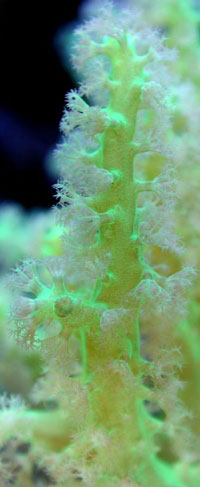
Photo courtesy of Robie Sayan.
|
The first reef aquarium I ever encountered
was quite a sight to behold. It was filled with a variety
of colorful soft corals, the polyps and branches swaying to
the rhythmic pulse of the currents. This aquarium caught my
attention because it was so fluid; I was entranced. It was
this tank that convinced me to set up a reef aquarium. Tanks
featuring soft corals were all too common around that time.
In fact, rarely did I see an Acropora or any other
small polyped stony corals for sale at the local fish store.
I remember that these types of stony corals were still considered
very challenging and best left to knowledgeable reefkeepers
with the best resources and husbandry skills.
My how things have changed! Significant
improvements in reef aquarium technology and a better understanding
of the needs of stony corals have allowed us to progress to
a time where Acropora and other stony corals can not
only survive, but also thrive. These significant strides in
the hobby have led to mass propagation of these corals, allowing
fragments to be shared with other reefkeepers. Today, tanks
dominated by small-mouthed stony corals are everywhere one
looks. Brilliant colors and shapes certainly make these tanks
a sight to behold. But along the way, I've noticed a general
decline in the number of aquaria dedicated to the corals that
paved the way for the current state of our hobby. Rarely do
I see a tank dedicated to soft corals anymore, and I feel
that this is somewhat of a shame. The variety and beauty found
among the Octocorallia are quite considerable, yet contemporary
aquarists rarely incorporate many of these corals in a reef
aquarium. This article is for those who still take the time
and resources to appreciate these corals, and to also encourage
others to perhaps dedicate an aquarium for them.
Why Keep Soft Corals?
Based on the husbandry skills needed to
keep this group, soft corals have a lot going for them. With
the exception of the non-photosynthetic species, many of the
commonly available soft corals are more forgiving and easier
to care for than smaller polyped stony corals. These include
the Leather Corals (Alcyonidae), False Leathers (Paralcyonidae),
Zoanthus spp., Rhodactis spp., Ricordea
spp., and Discosoma spp. They will thrive under a variety
of available fluorescent lighting fixtures, and tolerate lower
flow rates than seen in typical small polyped stony coral
aquariums. A total turnover of approximately ten times the
total tank volume is more than adequate. Calcium demand is
also much lower in a softie tank. One can avoid the need for
a calcium reactor, as kalkwasser or a simple two-part additive
solution will suffice. As a result of their more modest requirements,
a reef aquarium dedicated to the "easier" varieties
of soft corals is an ideal set up for a budding marine aquarist
or someone that lacks the desire for a complicated display
system.
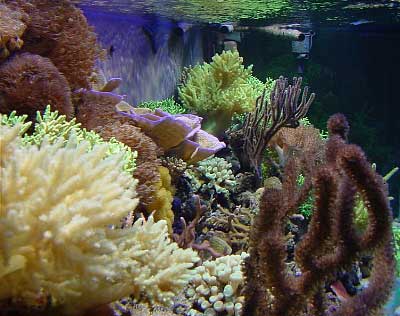 |
Side view of a beautiful soft coral dominated tank.
Photo courtesy of Ryan Baker.
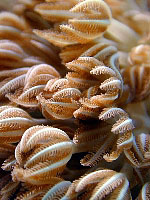
Photo courtesy of Kris Duggan.
|
Soft corals also break up the monotony
of the rigid stony corals. They offer movement and a different
appearance. I remember while entertaining guests, how the
first thing my company usually noticed in my previous tank
was the large Colt coral swaying back and forth, or the carpet
of green star polyps rustling in the current. Rarely would
I ever hear a comment about the beautiful purple branchy Acropora
colony growing nearby.
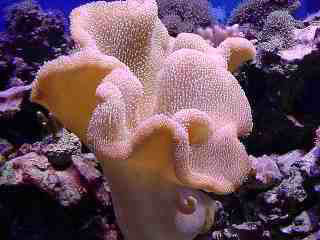 |
An interesting trait of some soft corals
is that they are very toxic or distasteful to potential predators.
Aquarists usually worry about the possible threats these chemicals
pose to their stony coral colonies. However, it can be an
asset in certain applications. Particularly noxious corals,
such as Sarcophyton and Lobophytum spp., are
usually unpalatable to many opportunistic corallivores, such
as certain Angelfish and Butterflyfish. Both of these types
of fish can wreak havoc on less toxic varieties of soft and
stony corals, but one could create a wonderful reef display
with these fish by choosing only toxic soft coral varieties.
It should be noted that some corallivores, like the Teardrop
Butterflyfish (Chaetodon unimaculatus) are unaffected
by the majority of soft coral toxins. Furthermore, many Butterflyfish
are obligate corallivores, which makes them poor candidates
for captivity. On the other hand, some of the available species
in these two families will readily adapt to food offered by
the aquarist. However, their occasional nips on coral specimens
can add up to a lot of damage in a confined reef aquarium.
In such a scenario, the use of more toxic varieties of soft
corals could allow for a pleasing display without much damage
from tankmates' feeding habits. Clownfish will also adopt
many soft corals as surrogate hosts when a suitable anemone
isn't available. This offers a neophyte aquarist a clownfish
host alternative to the more delicate anemone species.
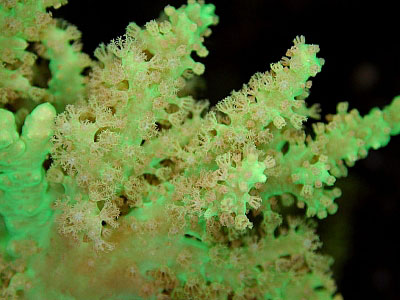 |
A beautiful soft coral, most probably a Nepthea sp.
Note the
bright flourescence.
Photo courtesy of Robie Sayan (ROBZ).
Lately, there are signs of a renewed interest
in soft corals. There is a great demand for colorful Ricordea,
Corallimorphs, and Zoanthus spp. Hopefully,
we'll see more soft coral dominant tanks in the future. They
are an attractive alternative to the multitudes of small polyped
stony coral dominant tanks.
A magnificient photo of a beautiful zoanthid and Ricordea
spp. dominated tank.
Photo courtesy of MUCHO REEF.
A final word about soft corals: in this
article I have categorized them into a broad group. It is
important to note that individual species can have vastly
different requirements to thrive. Please research the requirements
and needs of the corals you wish to purchase, and any livestock,
for that matter. Some notable softies to avoid are the Dendronephthya,
Scleronephthya, and other aposymbiotic soft corals.
Some heterotrophic softies are able to thrive in a reef aquarium,
but are less forgiving than the softies mentioned in this
article. For example, I have found that Gorgonians and Xenia
are a little more demanding when it comes to light and current.
Always decide first what you intend to keep and then design
your aquarium accordingly.
The beauty of a soft coral dominated tank is clearly seen
in this wonderful photo of Ryan's tank.
Photo courtesy of Ryan Baker.
|

